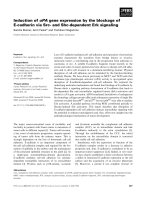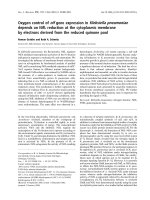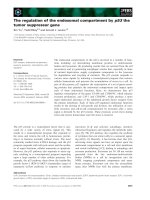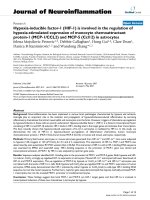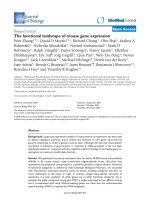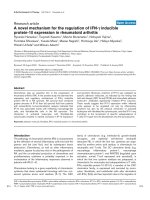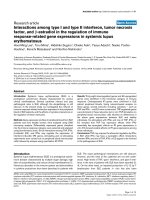The regulation of TXNIP gene expression
Bạn đang xem bản rút gọn của tài liệu. Xem và tải ngay bản đầy đủ của tài liệu tại đây (5.35 MB, 198 trang )
THEREGULATIONOF
TXNIPGENEEXPRESSION
FAXINGYU
(B.Sc.(Hons.),NUS)
ATHESISSUBMITTED
FORTHEDEGREEOFDOCTOROFPHILOSOPHY
DEPARTMENTOFBIOCHEMISTRY
NATIONALUNIVERSITYOFSINGAPORE
2009
Acknowledgments
Ifirstthankmysupervisor,Dr.YanLuo,forhisvaluablecommentsonhowto
designandperformexperiments,forhisgenerousgivingoffreedomtoexplorenew
fields,forhisenthusiasticencouragementwhenIencountereddifficulties,andforhis
criticalread ingandsuggestionsonmymanuscripts andthesis.Itisimpossibleto
havethis thesis presented herewithout Dr. Luo’s patient guidance throughout my
graduatestudy.
I wish to thank Drs. Edwin Cheung and Xinmin Cao, my thesis advisory
committeemembers,forsharingtheirknowledgeandwisdom.Ialsowishtothank
Drs. Thilo Hagen and Ruping Dai for their constructive comments and friendly
discussionsonmyprojects.
IwouldalsoliketothankpastandpresentmembersofLuolab; allofushave
constructedaharmoniousandproductiveworkingenvironment.Specialthanksto
ShuangruGoh,shehasexperimentallycontributedtoaportionofresultsdescribed
inthisthesis,andDrs.HongpengHe,LilingZhengandMingjiJin,whohavegiven
mewonderfulsuggestionsonthesiswriting.
Finally,Ithankmylovingwife,myparents,mysiblings,mygrandpa,andother
familymembersfortheirunderstanding,supportsandsacrificesintheseyears.
I
TableofContents
page
Acknowledgments I
TableofContents II
Summary IX
ListofTables XI
ListofFigures XII
Abbreviations XVII
Chapter1Introduction 1
1.1AGeneralOverviewofEukaryoticGeneTranscription 1
1.1.1RNAPolymerases 1
1.1.2CorePromotersandGeneralTranscriptionFactors(GTF) 2
1.1.3Sequence‐specificTranscriptionFactors 3
1.1.4Cofactors 4
1.1.5OtherRegulatoryMechanisms 6
1.2ExtracellularSignalsRegulateGeneTranscription 7
1.2.1InternalSensorsRegulateTranscriptionFactors 7
1.2.2CellPermeableLigandsRegulateTranscriptionFactors 9
1.2.3PlasmaMembraneReceptorsRegulateNuclearTranscription
Factors
9
1.2.4PlasmaMembraneReceptorsRegulateCytoplasmicTranscription
Factors
10
II
1.3ThioredoxinInteractingProtein(Txnip) 10
1.4TxnipFunctions 14
1.4.1TxnipandRedoxState 14
1.4.2TxnipandCellProliferationandCellDeath 15
1.4.3TxnipandCellDifferentiation 18
1.4.4TxnipandCellularMetabolism 18
1.5TxnipExpressioninResponsetoDifferentSignals 20
1.6Objectives 23
Chapter2MaterialsandMethods 25
2.1ChemicalsandBuffers 25
2.2PlasmidConstructs 25
2.3PurificationofBacteriallyExpressedRecombinantProteins 26
2.4MammalianCellCulture 27
2.5SodiumDodecylSulfatePolyacrylamideGelElectrophoresis
(SDS‐PAGE)
27
2.6Immuno‐Blot 27
2.7RNAExtraction,RT(ReverseTranscription)‐PCRandReal‐TimePCR 28
2.8GenomicDNAExtra ction 29
2.9SmallInterferingRNAs(siRNAs)andRNAInterferenceAssays 29
2.10Transfection 30
2.11PromoterActivity(Reporter)Assays 30
2.12Immunocytometry 30
2.13Fluorescence‐activatedCellSorting(FACS) 31
III
2.14ElectrophoresisMobilityShiftAssays(EMSA) 31
2.15ChromatinImmunoprecipitation(ChIP)Assays 34
2.16ThioredoxinActivityAssays 35
2.17GlucoseTransportAssays 35
2.18StatisticalAnalyses 36
Chapter3IdentificationofMoleculesModulatingTxnipExpression 37
3.1Preface 37
3.2Results 38
3.2.1Adenosine‐containingMoleculesInduceTxnipExpression 38
3.2.1.1NAD(H)andATPStimulateTxnipExpression 38
3.2.1.2MoleculesContainingAdenosineGroupInduceTxnip
Expression
40
3.2.1.3AdenosineisNecessaryandSufficientforInducingTxnip
Expression
40
3.2.1.4Adenosine‐containingMoleculesInduceTxnipExpression
inaDose‐dependentManner
43
3.2.1.5LongTermEffectofAdenosine‐containingMoleculeson
TxnipExpression
44
3.2.1.6Adenosine‐containingMoleculesInduceTxnipExpression
attheTranscriptionalLevel
45
3.2.1.7Adenosine‐containingMoleculesInduceTxnipExpression
IsMediatedbyanEarlierDefinedChoRE
47
3.2.1.8TheMLX/MondoAComplexMediatestheInductionof
TxnipExpressionbyAdenosine‐containingMolecules
49
3.2.1.9Adenosine‐containingMoleculesFacilitateMondoA
NuclearTranslocation
52
IV
3.2.1.10GlucoseIsRequiredfortheInductionofTxnipExpression
byAdenosine‐containingMolecules
54
3.2.1.11GlucoseInducedTxnipExpressionIsAmplifiedby
Adenosine‐containingMolecules
56
3.2.1.12PotentialPlasmaMembraneTarget(s)ofAdenosine‐
containingMolecules
57
3.2.1.12.1PurinergicReceptorsAreNotRequiredforthe
InductionofTxnipExpression
59
3.2.1.12.2Adenosine‐containingMoleculesMayTarget
AdenosineTransporters
59
3.2.1.13SignalingPathway(s)EvokedbyAdenosine‐containing
MoleculesforRegulatingTxnipExpression
62
3.2.1.13.1TheInductionofTxnipExpressionRequires
IntracellularCa
2+
62
3.2.1.13.2TheInductionofTxnipExpressionDoesNot
RequirecAMP
64
3.2.1.13.3TheInvolvementofMAPKintheInductionof
TxnipExpression
64
3.2.1.13.4Non‐involvementofAMPKintheInductionof
TxnipExpression
66
3.2.1.14Adenosine‐containingMoleculesRepressThioredoxin
ActivityandGlucoseTransport
67
3.2.1.15Adenosine‐containingMoleculesAffectCellCycle
Progression
69
3.2.2EffectsofGlucoseAnalogsonTxnipExpression 70
3.2.2.1EffectsofSelectedMonosaccharidesandDisaccharideson
TxnipExpression
70
3.2.2.2EffectofPD169316onGlucose,2DGorMaltose/NAD
+
InducedTxnipExpression
75
V
3.2.2.3ACa
2+
ChelatorAbolishestheStimulatoryEffectofGlucose
onTxnipExpression
75
3.2.3InhibitorsofOxidationPhosphorylationRepressedTxnip
Expression
76
3.2.3.1NitricOxide(NO)andSodiumAzide(NaN
3)RepressTxnip
Expression
76
3.2.3.2InhibitionofOxidativePhosphorylationRepressesTxnip
Expression
80
3.2.3.3ACa
2+
ChelatorRescuesTxnipExpressioninthePresenceof
OxidativePhosphorylationInhibitors
82
3.3Discussion 83
3.3.1Adenosine‐containingMoleculesMayRemainExtracellularto
InduceTxnipExpression
83
3.3.2PotentialMembraneTargetsforAdenosine‐containingMolecules 84
3.3.3SignalingPathway(s)InvolvedintheInductionofTxnip
ExpressionbyAdenosine‐containingMolecules
85
3.3.4TheMondoA/MLXComplexMediatesTxnipExpression 87
3.3.5PhysiologicalSignificance 89
3.3.6TwoSignalingPathwaysEvokedbyGlucoseforInducingTxnip
Expression
91
3.3.7TxnipExpressionIsaSensorofOxidativePhosphorylationStatus 93
3.4ConclusionandPerspectives 94
Chapter4RegulatoryMechanismsUnderlyingtheInductionofTxnip
ExpressionbyGlucoseorAdenosine‐containingMolecules
96
4.1Preface 96
4.2Results 98
VI
4.2.1RegulatoryMechanismsatthePromoterLevelGoverning
GlucoseorAdenosine‐containingMoleculesInducedTxnip
Expression
98
4.2.1.1TxnipPromoterRegionsCriticalforExpressionInduction
byNAD
+
orGlucose
98
4.2.1.2TandemChoREsonTxnipPromoters 102
4.2.1.3TheMondoA/MLXComplexBindstoBothChoREsinvitro 105
4.2.1.4BothChoREsareRequiredforOptimalTxnipPromoter
Activity
108
4.2.1.5ChoREsAreNotSufficientfortheInductionofTxnip
Expression
111
4.2.1.6TandemNF‐YBindingSitesAreRequiredfortheInduction
ofTxnipExpression
111
4.2.1.7NF‐YMediatedInductionofTxnipExpressionbySAHA
RequiresMondoA/MLX
114
4.2.1.8TxnipPromoterRecruitsMondoA/MLXComplexinan
NF‐YDependentManner
116
4.3TheRoleofUSFsinTxnipExpression 121
4.3.1ExpressionandPurificationofHis‐taggedUSF1 121
4.3.2USF1InteractswithChoRESitesinvitro 122
4.3.3Down‐regulationofUSFsReducesTxnipExpression 125
4.3.4Over‐expressionofUSFsInducesTxnipPromoterActivity 127
4.3.5USFIsNotInvolvedintheTxnipInductionby
Adenosine‐containingMolecules
129
4.3.6USFIsNotInvolvedintheTxnipInductionbyGlucose 132
4.4Discussion 133
4.4.1TandemChoREsontheTxnipGenePromoter 133
VII
4.4.2FullInductionofTxnipExpressionRequiresBothChoREsand
CCAATBoxes
134
4.4.3NF‐YandMondoA/MLXCooperatetoStimulateTxnip
Expression
136
4.4.4TheRoleofUSFsonTxnipExpression 138
4.5ConclusionandPerspectives 140
References 143
Appendices 162
AppendixI,Buffers/GelsUsedinThisStudy 162
AppendixII,RNAIntegrity 165
AppendixIII,PrimerSpecificity 166
AppendixIV,PrimersUsedinThisStudy 167
AppendixV, Paper1(Abstract) 172
AppendixVI,Paper2(Abstract) 173
VIII
Summary
Thioredoxininteractingprotein(Txnip)isamultifunctionalproteininvolved
inregulation ofcellcycleeventsandcellularmetabolism.TheexpressionofTxnipis
induced by glucose, and this induction is mediated by a carbohydrate response
element (ChoRE) on Txnip promoter and its associated transcription factors,
MondoA and Max‐like proteinX (MLX).In this study,I havediscoveredthat the
transcription of the Txnip gene is induced by an array of adenosine‐containing
molecules, of which an intact adenosine moiety is necessary and sufficient.The
induction of Txnip expression by adenosine‐containing molecules is glucose
dependent,andMondoAandMLXhavebeenshowntoconveystimulatorysignals
from extracellularmolecules tothe Txnippromoter. Therefore,the regulatoryrole
ofadenosine‐containingmolecules isexerted viaamplifying glucose signaling,and
thissuggeststhatthesemoleculesmaymodulatethekineticsofglucosehomeostasis.
I have also studied the underlying regulatory mechanisms of glucose and
adenosine‐containingmoleculesonTxnipexpression.AnadditionalChoREonthe
promoter of Txnip gene has been identified, and this ChoRE is able to recruit
MondoA and MLXin a similar fashionas the previously identified ChoRE in vitro
and in vivo.Both ChoREs function cooperatively to mediate optimal Txnip
expression under glucoseor adenosine‐containingmolecules treatment.However,
thesetwoChoREsarenotsufficienttomediatetheinductionofTxnipexpressionby
glucoseoradenosine‐containingmolecules,andtwoCCAATboxes,bothcanrecruit
IX
nuclearfactorY(NF‐Y)totheTxnippromoter,arealsorequiredfortheinduction.I
also found that the function of ChoREs and associated factors is contingent on
tandemCCAATbo xes,inthattheoccupancyoftheTxnippromoterbytheCCAAT
box‐associatedNF‐Yisaprerequisit eforefficaciousrecruitmentofMondoA/MLXto
ChoREs under glucose stimulation.Such a strategy suggests a synergy between
NF‐Y and MondoA/MLX in enhancing Txnip expression presumably through
inducingdynamicchromatinchangesinresponsetodiversephysiologicalinducers.
X
ListofTables
Page
Table1.OligonucleotidesusedforEMSA. 32
Table2.PrimersusedinChIPassay. 33
Table3.Theeffectsofdifferentmolecules onTxnipmRNAlevels. 41
XI
ListofFigures
Page
Figure1.Asimplifiedversionofeukaryotictranscriptionmachineryand
transcriptionregulatorymechanisms.
5
Figure2.Possiblemechanismsfortheregulationofgenetranscriptionby
extracellularmoleculesandinternalenvironmentchanges.
8
Figure3.AphylogenetictreeofTxniporthologsfromdifferentorganisms. 11
Figure4.GenestructuresofTxnip,arrestinβ2andARRDCgenes. 13
Figure5.ProteinprimarystructureofTxnip,arrestinβ2andARRDCs. 14
Figure6.SignalingpathwaysregulatingTxnipexpressionandtheir
targetingcis‐regulatoryelementsonTxnippromoter.
21
Figure7.NAD(H)orATPinducedTxnipmRNAlevel. 38
Figure8.NAD
+
inducedTxnipproteinlevel. 39
Figure9.NAD(H)orATPinducedTxnipexpressionindiversecelllines. 40
Figure10.NAD
+
andATPshareacommonadenosinegroup. 41
Figure11.StructureofATP ,dATP,Bz‐ATPorTnp‐ATP . 42
Figure12.Titrationsofadenosine‐containingmoleculesonTxnipexpression. 43
Figure13.Timecourseofadenosine‐containingmoleculesonTxnip
expression.
44
Figure14.Adenosine‐containingmoleculesinduceTxnippromoteractivity. 45
Figure15.Adenosine‐containingmoleculesdidnotinduceTxnipexpression
inthepresenceofactinomycinD.
46
Figure16.NAD
+
orATPdidnotinduceactivityofChoRE‐mutatedTxnip
promoters.
48
XII
Figure17.NAD
+
orATPcouldnotinduceTxnippromoteractivityinthe
presenceofdominantnegativeMLX.
48
Figure18.EffectsofectopicMLXand/orMondoonTxnippromoteractivity. 50
Figure19.EffectsofsiRNAsagainstMLXorMondoAonTxnipexpression. 51
Figure20.LocalizationofHA‐MondoAinL6cellsundercontrolor2DG
treatment.
53
Figure21.MondoAnucleartranslocationwasfacilitatedbyadenosine‐
containingmolecules.
53
Figure22.Glucose‐dependentinductionofTxnipexpressionbyNAD
+
orATP. 55
Figure23.NAD
+
inducedTxnipexpressionina widetitrationofglucose. 56
Figure24.TheinductionofTxnipexpressionwasnotabolishedbyARL
67156.
57
Figure25.Inhibitorsforpurinergicreceptorsdid notinhibittheinductionof
TxnipexpressionbyNAD
+
orATP .
59
Figure26.StructuresofAdenosine,NBTI,DipyridamoleorDilazep. 60
Figure27.TheeffectofNAD
+
orATPonTxnipexpressionwasblockedby
inhibitorsofadenosinetransporters.
61
Figure28.EffectofCa
2+
chelatorsonTxnipexpression. 62
Figure29.cAMPsignalingpathwaydidnotmediatetheinductionofTxnip
expressionbyNAD
+
.
63
Figure30.TheeffectofMAPKinhibitorsonTxnipexpressionanditsresponse
toNAD
+
orATPinU2OScells.
65
Figure31.TheeffectofMAPKinhibitorsonTxnipexpressionanditsresponse
toNAD
+
orATPinHeLacells.
66
Figure32.AMPKwasnotinvolvedintheinductionofTxnipexpressionby
adenosine‐containingmolecules.
67
Figure33.Adenosine‐containingMoleculesRepressedThioredoxinActivity. 68
XIII
Figure34.Adenosine‐containingMoleculesInhibitedGlucoseTransport. 68
Figure35.NAD(H)treatmentrepressedcellcycleprogression. 69
Figure36.NAD(H)treatmentselevatedp21
cip1
expressionlevel. 70
Figure37.Structuresofglucoseanalogsandtheirfateincellularmetabolism. 71
Figure38.TheeffectofglucoseandglucosehomologsonTxnipexpressionin
theabsenceorpresenceofNAD
+
.
72
Figure39.TheeffectofPD169316onTxnipinductionbydifferent
carbohydratesand/orNAD
+
.
74
Figure40.GlucoseinducedTxnipexpressionwasrepressedbyBAPTA‐AM. 76
Figure41.EffectsofNOdonorsandGCinhibitoronTxnipexpression. 77
Figure42.TheeffectofNOonTxnipexpressionwasnotmediatedbyGC. 78
Figure43.TheeffectofNaN
3onTxnipmRNALevels. 79
Figure44.Asimplifiedrepresentationofoxidativephosphorylation. 80
Figure45.EffectsofoxidativephosphorylationinhibitorsonTxniporH2B
expression.
81
Figure46.OxidativephosphorylationinhibitorsdidnotrepressTxnip
expressioninthepresenceBAPTA‐AM.
82
Figure47.Anegativefeed‐backloopforglucoseuptake. 90
Figure48.AschematicrepresentationoftruncatedTxnippromoters. 99
Figure49.ResponsesofTxnippromoterstoNAD
+
. 99
Figure50.ResponsesofTxnippromoterstoNAD
+
orGlucose. 100
Figure51.TheminimalTxnipprom otersequencerequiredformediatingthe
stimulatoryeffectofNAD
+
.
101
Figure52.cis‐regulatoryelementsonTxnippromoter. 102
Figure53.AlignmentofTxnippromotersfromdifferentspecies. 103
XIV
Figure54.PhylogenetictreeofTxnippromoters. 104
Figure55.SequencealignmentoffishandfrogTxnippromoterswiththe
humanTxnippromoter.
105
Figure56.EMSAsusingtwoTxnippromotersegmentscontainingChoRE‐a
orChoRE‐b.
106
Figure57.Responsesofwild‐type(WT)orChoREmutantTxnippromotersto
NAD
+
orglucose.
109
Figure58.EffectofsiRNAsagainstMLXorMondoAonTxnippromoter
activities.
110
Figure59.TheresponseofhybridTxnippromoterstoNAD
+
orglucose. 112
Figure60.Responsesofwild‐type(WT)orCCAATboxmutantTxnip
promoterstoNAD
+
orglucose.
113
Figure61.TheeffectofSAHA. 115
Figure62.StablecelllinesforChIPassays. 117
Figure63.RecruitmentofMLXandNF‐Ytorespectivetargets(ChoREsand
CCAATboxes)assessedbyChIPassays.
118
Figure64.MLXisnotrecruitedontoCCAATboxes‐mutatedTxnippromoter. 119
Figure65.Theinteraction betweenMLXandChoREisglucosedependent. 121
Figure66.BacterialexpressionofUSF1. 121
Figure67.His‐USF1interacts with ChoRE‐aorChoRE‐b. 122
Figure68.ChoRE‐containingprobesinteractwithaprotein(s)inHeLanuclear
extract(NE).
124
Figure69.BandsshiftbyUSFantibodies. 125
Figure70.Theeffects ofUSF1‐orUSF2‐specificsiRNAsonTxnipexpression. 126
Figure71.TheinductionofTxnippromoteractivitybyover‐expressionof
USFs.
127
XV
Figure72.TheresponseofTxnippromotertoNAD
+
orATPunderUSF
over‐expression.
128
Figure73.EffectsofUSFover‐expressionontheactivitiesoftruncatedor
mutantTxnippromoters.
130
Figure74.A‐USFdidnotrepresstheinductionofTxnippromoteractivityby
NAD
+
orATP.
131
Figure75.A‐USFdidnotrepresstheinductionofTxnippromoteractivityby
glucose.
132
Figure76.AmodelforthetranscriptionalregulationoftheTxnipgene
promoterbyNF‐Y,MondoA/MLXandother(co)factors.
137
XVI
Abbreviations
2DG 2‐deoxy‐glucose
3OMG 3‐O‐Methylglucose
5‐aza‐CdR 5‐AZA‐2ʹ‐deoxycytidine
AC Adenylylcyclase
AICAR 5‐aminoimidazole‐4‐carboxamide
ribonucleoside
AP‐1 Activatorprotein1
ARRDC Arrestindomaincontaining
ASK‐1 Apoptosissignal‐regulatingkinase1
BrdU Bromodeoxyuridine
cAMP Cyclicadenosinemonophosphate
CDK4 Cyclin‐dependentkinase4
cDNA ComplementaryDNA
ChIP Chromatinimmunoprecipitation
ChoRE Carbohydrateresponseelement
ERK Extracellularsignal‐regulatedkinases
EMSA Electrophoresismobilityshiftassay
FACS Fluorescence‐activatedcellsorting
FCHL Familialcombinedhyperlipidemia
FOXO1 ForkheadboxO1
G6P Glucose‐6‐phosphate
XVII
GC Guanylatecyclase
Glut Glucosetransporter
GPCR G‐proteincoupledreceptors
GR Glucocorticoidreceptor
GRE Glucocorticoidresponseelement
GTF Generaltranscriptionfactors
HA Hemagglutinin
HAT Histoneacetyltransferases
HDAC Histonedeacetylases
HDMT Histonedemethylases
HIF‐1 Hypoxia‐inducingfactor1
HMT Histonemethyltransferases
HRE HIF‐responsiveelement
HSE Heatshockresponseelements
HSF‐1 Heatshockfactor1
HSP Heatshockproteins
HXT Hexosetransporter
IP Immunoprecipitation
IPTG Isopropyl‐beta‐D‐thiogalactopyranoside
Jab‐1 Junactivationdomain‐bindingprotein1
JAK Januskinase
JNK c‐JunN‐terminalkinases
XVIII
MAPK Mitogen‐activated
proteinkinase
MLX Max‐likeproteinX
mRNA MessengerRNA
mTOR Mammaliantargetofrapamycin
NE Nuclearextract
NF‐κB Kappa‐light‐chain ‐enhancerofactivatedBcells
NF‐Y NuclearfactorY
NO Nitricoxide
Oct‐1 Octamer‐1
PIC Pre‐initiationcomplex
PKA ProteinkinaseA
PKB/AKT ProteinkinaseB
PKG ProteinkinaseG
PolII RNApolymeraseII
PP2A Proteinphosphatase2A
PPAR Peroxisomeproliferator‐activatedreceptor
PPRE Peroxisomeproliferatorhormoneresponseelement
PTEN Phosphataseandtensinhomolog
ROS Reactiveoxygenspecies
RTK Receptortyrosinekinases
SAHA Suberoylanilidehydroxamicacid
SDS‐PAGE Sodiumdodecylsulfatepolyacrylamidegelelectrophoresis
XIX
SGLT Na
+
/glucosesymporter
siRNA SmallinterferenceRNA
STAT Signaltransducersandactivatoroftranscription
TBP‐2 Thioredoxin‐bindingprotein2
TGF‐β Transforminggrowthfactorbeta
Txnip ThioredoxinInteractingProtein
USF Upstreamstimulatoryfactor
VDRE VitaminDresponseelement
VDUP1 VitaminD
3up‐regulatedprotein1
XX
Chapter1
Introduction
Chapter1
1.1AGeneralOverviewofEukaryoticGeneTranscription
GeneticinformationisstoredintheformofDNA.Toexerttheirfunctions,
genes are required to be expressed to RNA or proteins.Transcription, or RNA
synthesis,istheprocessoftranscribingsequenceinformationfromDNAtoRNAina
complementarymanner.RNAinturncanbeusedastemplateforproteinsynthesis,
thisprocessiscalledtranslation.
1.1.1RNAPolymerases
Transcription is a biochemical reaction catalyzed by RNA polymerases.In
eukaryotes,three typesof RNApolymerases have been identifiedand respectively
dubbed as RNA polymerase I, II and III (Roeder and Rutter, 1969).Among these
polymerases,RNApolymeraseIisresponsibleforthesynthesisofribosomalRNAs
(rRNA);RNApolymeraseII(PolII,orRNAPII)mediatesthesynthesisofmessenger
RNAs(mRNA),somesmallnuclearRNAs(snRNA),smallnucleolarRNAs(snoRNA)
andmicroRNAs;andRNApolymeraseIIIisresponsibleforthesynthesisoftransfer
RNAs(tRNA),5SrRNAandsomesnRNAs(RoederandRutter,1970;Leeetal.,2004).
Novel RNA polymerases have also been discovered recently that are involved in
synthesis of some specific RNAs (e.g., synthesis of certain small interfering RNAs
[siRNA]inplants[Herretal.,2005]).
PolIIisaproteincomplexcontaining12subunitsencodedbydifferentgenes;
among these subunits, some are Pol II‐specific while others are shared with other
RNApolymerases(Sklaretal.,1975).Thesynthesisofprotein‐codingmRNAsbyPol
II is a complicated process facilitated by many other factors, and is controlled by
multipleregulatorypathwaystomeetthespatialandtemporalrequirementforthe
expressionofspecificgenes.Thelastfourdecadeshavewitnessedextensivestudies
1
Chapter1
onthestructure,functionandregulationofPolIIusingbiochemical,structuraland
geneticapproaches(reviewedinRoeder,2003;LevineandTjian,2003;andKornberg,
2007).
1.1.2CorePromotersandGeneralTranscriptionFactors(GTF)
ForagivenmRNAencodinggene,acorepromoterisdefinedastheminimal
DNA sequence required for accurate transcription initiation.Core promoters are
typicallypositionedaroundthetranscriptionstartsite(~35nucleotidesupstreamor
downstream)andcontainsignatureelementsincluding,tonameafew,TATAbox,
initiator(Inr)anddownstreamcorepromoterelement(DPE)(ButlerandKadonaga,
2002).Thereappears to be no universal core promoterelements; forinstance, few
housekeepinggenes,suchastheoneencodinghistone1,containaTATAboxinthe
promoters (Cooper et al., 2006; Isogai et al., 2007).I am working on a TATA box‐
containinggene,thereforebelowIwillfocusontheintroductionofTATA‐regulated
promoters/genes.
Although RNA polymerases are enzymes responsible for RNA synthesis,
theyaloneareunabletoinitiateaccuratetranscription(Weiletal.,1979).Sixancillary
protein or proteincomplexes, namely TFIIA, TFIIB, TFIID, TFIIE, TFIIF and TFIIH
(respectively,transcriptionfactorsA,B,D,E,FandHforPolII),havebeenisolated
andcharacterizedfrom wholecellornuclearextracts;they(withatotalof32distinct
polypeptides) are collectivelycalled general transcription (initiation)factors (GTFs,
Figure 1; Matsui et al., 1980; Samuels et al., 1982; Reinbergand Roeder, 1987a;
ReinbergandRoeder,1987b;Floresetal.,1990;Floresetal.,1992).PolIIandGTFs
canformapre‐initiationcomplex(PIC)importantforaccuratetranscriptioninitiation
fromacorepromoteratabasallevel(VanDykeetal.,1988;Buratowskietal.,1989).
2
Chapter1
GTFsarewidelyexpressedandrequiredfortranscriptionofmajority,ifnot
all, mRNA genes; however, a subset of cellular genes may require a subset of the
GTFsthatalongwithcertainspecialized(co)factorsbringsabouttissue‐and/orgene‐
specifictranscriptionalactivation(reviewedinGreen,2000;Berk,2000).
1.1.3Sequence‐specificTranscriptionFactors
ManyevolutionaryconservedshortDNAsequenceshavebeenidentifiedon
promoter region of most genes, and these short DNA elements (cis‐regulatory
elements)areabletomediatetranscriptionregulationbyrecruitingsequence‐specific
transcription factors.The proximal sequencesupstream (~250) ofthe transcription
startsiteusually containprimaryregulatoryelements, andthese regionsarecalled
proximal promoters.Less frequently, some elements are located proximally or
distally downstream, or at distal regions upstream, of the transcription start site.
Theseelementsare knownas distal promoterorenhancerelements.Among these
cis‐regulatory elements, some can recruit positive regulatory factors (transcription
activators); on the other hand, some can recruit negative regulatory factors
(transcription repressors).For convenience, these two types of cis‐regulatory
elementsaredubbed,respectively,enhancerandrepressor(Figure1).
Sequence‐specific transcription factors occupy enhancers or repressors via
multiple interactions, such as hydrogen bonds, ionic bonds and hydrophobic
interactions.Thesetranscriptionfactorsusuallycontainstructures(withmultipleα
helices, loops orβsheets) which can bind to the major groove of DNA.Such
structures include Helix‐Turn‐Helix motifs, Zinc Fingers, Leucine Zippers, Helix‐
Loop‐Helix motifs and possibly others (Alberts et al., 2002).For instances, the
homeodomain of octamer‐1 (Oct‐1) is a Helix‐Turn‐Heli x motif, and this motif is
3

